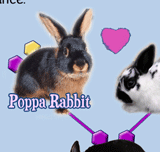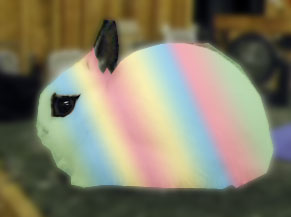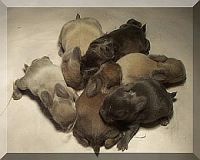Rabbit Fur Colors Genetics And Other Rabbit Genetics Information
*NOTICE!* We are planning a new article on the Blue-eyed White or Vienna gene in rabbits! If you have any photos of VM, VC, or BEW rabbits that you would be willing to share, or any experiences with this gene that you find remarkable, please e-mail us at admin @ the nature trail dot com. We’d love to hear from you!
Rabbit coat color is primarily determined by five genes. Luckily, the denotations for the genes are easy to remember. They are A, B, C, D, and E. Thank goodness for small favors. Unfortunately, it gets a little more complicated from here.
Before going further, let’s brush up on our basic high school genetics. Each parent donates one of a pair of each type of gene to its offspring. The offspring have two of each gene; one from each parent. Dominant genes are expressed (you can see the characteristics in the rabbit) and recessive genes are carried to be possibly passed on to offspring. Each gene, regardless of its dominance or recessive quality, is passed on to roughly half of the offspring.
 New Article! Primer on Hereditary Rabbit Genetics
New Article! Primer on Hereditary Rabbit Genetics
Fun new article illustrated with super cute charts. Definitely start here if you are new to genetics!
The Agouti Gene
. . .The “a” gene comes in three forms: “A,” which is responsible for agouti rabbits; “at,” which is responsible for otters, tans (rare) and martens; and “a,” which is responsible for “self” colored rabbits. The agouti rabbits include chestnut, opal, chinchilla and ermine, among others. The “at” gene produces black otters, sable point martens, blue otters, and the like. . . Read More >>>>>
The Black-Chocolate Gene
. . . Any Holland Lop you see either belongs to the black family of colors or the brown (chocolate) family of colors–regardless of the main color that you see when you look at the rabbit. The vast majority of Holland Lops you will see at a show or at the typical barn belongs to the black family. Black family colors include black . . .Read More >>>>>
The Color Gene
The C gene is responsible for rabbits being full color, chinchilla, seal, sable point, pointed white, or ruby-eyed white (REW). Read More >>>>>
The Dense/Dilute Gene
. . . So what are dilute rabbits? They are just like dense rabbits except that there is less pigment in each hair. In the black color family, two dilute genes will turn the black to blue. In the chocolate family of rabbits, two dilute genes will turn the chocolate to lilac. . . . Read More >>>>>
The Extension Gene
The E/e gene controls whether the basic color on the rabbit (black, blue, chocolate, or lilac) is extended all of the way to the end of the hair shaft or whether the basic color stops and another finishes the hair shaft (such as the orange color on the back of a black tortoiseshell). When a rabbit has full extension, it tends to look the same color all over, such as with a blue rabbit. When there is non-extension, such as with a black tortoiseshell, the rabbit takes on a shaded look since the shorter hairs on the belly, guard hairs, feet and muzzle get only the basic color . . . Read More >>>>>
 144 Rabbit Coat Colors and Their Genotypes
144 Rabbit Coat Colors and Their Genotypes
This chart shows 144 rabbit coat colors including variations on color names as used by Holland lops. The first third of the chart is self colors. The second third is otter/tan/marten colors. The last third is agouti colors. Each line shows a color family that varies only by the C-gene. Each row of dense colors is followed by the corresponding dilute color. Two rows of black family colors are followed by two rows of the corresponding chocolate family colors. Four rows of full-extension colors are followed by the corresponding four rows of non-extension colors. In other words, the chart of colors is organized to progress logically from color to color and to show you the relationships between colors.
The Dwarf Gene
With regard to the dwarf gene, Holland lops come in three types: true dwarfs, false dwarfs, and peanuts. Peanuts do not grow and always die, usually within a few days, but occasionally last a week or two. False dwarfs are also called “normals” and can make good brood animals. Show rabbits are typically true dwarfs. . . . Read More >>>>>
The Pattern Gene
. . . Broken patterned Holland Lops can be any color of Holland Lops, except that the colored portions occur in a patched or a blanketed pattern with white fur in between (blanketed is more common in Holland Lops). Ideally, a broken patterned Holland Lop should have a balanced marking on its nose. . . Read More >>>>>


